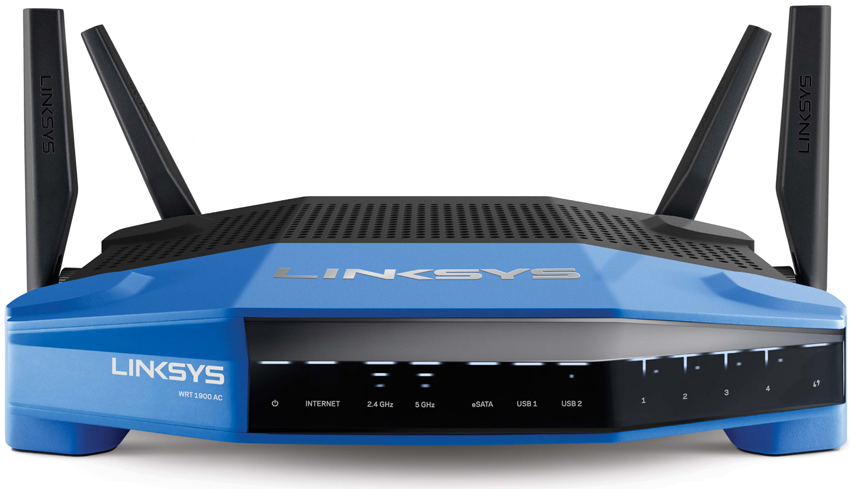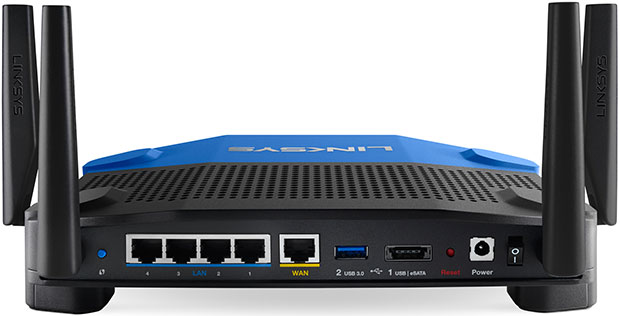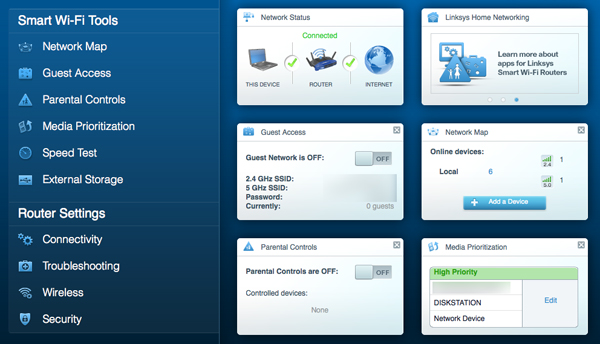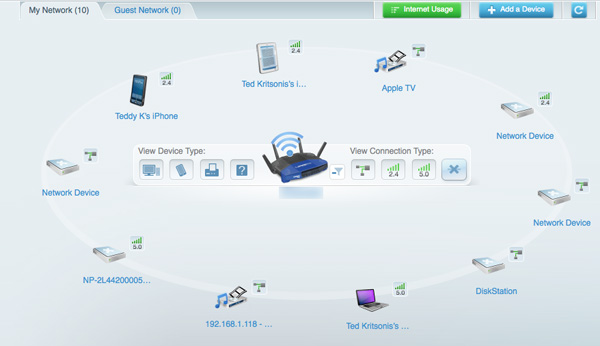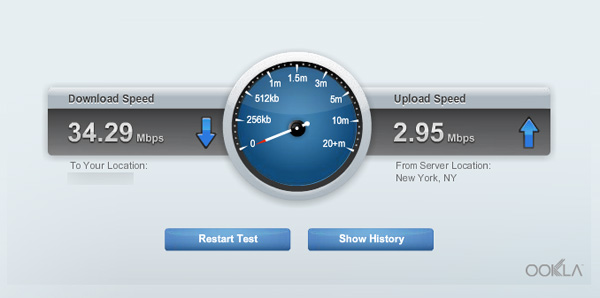Despite the fact Belkin now controls the Linksys brand, the WRT1900AC router is an ode to Linksys’ past with its black-and-blue colour scheme and monster truck-style design. Powerful, robust and consistent, it is easily one of the best routers currently available on the market.
The look and feel of the WRT1900AC is a departure from what Linksys has tried to do the last few years — make routers actually look nicer and less like utility gizmos. This router won’t win any awards for being pretty, but it will undoubtedly make networking purists happy with its retro look. It is both wall-mountable and stackable, just like the old ones used to be, though Linksys hasn’t yet revealed what it can be stacked on top of.
It’s considerably bigger than the company’s previous top router, the AC1750, and comes with four antennas out of the box that screw in each of the four ports found on the unit.
Under the hood, it runs on a 1.2GHz ARM-based dual-core processor, 256MB of RAM and 128MB of flash storage. There are four Ethernet ports, one USB 3.0 port and another USB 2.0 port that can double as an eSATA port for those who love using that. The WRT1900AC will also be compatible with third-party firmware from OpenWRT, DD-WRT and Tomato, which is sure to make networking aficionados happy, too.
The four antennas are an interesting part of the story here, largely because high-end routers usually have three. They don’t all work together because the router can only output three spatial streams at once, but since there are four functioning, it prioritizes the ones that are working the best. For example, if one is struggling for whatever reason, the router cuts it off from transmitting and delegates the task to one that can handle more throughput. Linksys says this improves overall performance, and in our testing, we tend to agree.
Setup is pretty straightforward, and we liked that Linksys has at least taken a step to simplify the process. Out of the gate, the router works with a network name and password that comes in the pamphlet in the box, but we preferred to set up our own network, especially since we like having a dual-band environment. As with previous Linksys routers, we could have a 2.4GHz network and 5.0GHz running at the same time, plus a guest network.
We went through the browser-based management software at linksyssmartwifi.com and logged in with an existing Smart Wi-Fi account (new users could set up a new one). From there, we set up things like our network names and passwords, Media Prioritization, USB Storage and a couple other things. Parental controls (for blocking access in certain timeslots) and guest network access (one for each band, which is a first) are readily available here, and you can do speed tests to gauge how much throughput you’re dealing with. The layout isn’t any different than what it was before, and users who prefer more robust manual options will likely keep away from this interface since it doesn’t go deep enough.
We liked that we could manage the router using the Smart Wi-Fi app on an iOS or Android device, both at home or remotely. Again, this isn’t new and has been around for a while, though we do appreciate that the app’s performance is a little smoother now. Whether it be through the app or a browser, the Network Map is a snapshot overview of what your home network looks like. All of the devices connected, be they wired or wireless, are displayed. We would’ve liked if the router could actually name some of the units we had connected, like the Roku 3 and Roku Streaming Stick, for instance. It knew we had an Apple TV and we could tell which unit was the Sonos Play:3, but had to check IP addresses to identify the others. The good thing is that you can rename the unknown connections to better manage everything.
We liked the USB storage options, specifically using the USB 3.0 port to plug in an external drive to share across the network. By default, the drive could be seen and accessed by every device in the network that can see it. Since the WRT1900AC supports DLNA and UPnP standards out of the box, streaming media from the drive is fairly easy and effortless. Our two Roku devices were able to see it, as well as all the computers, tablets and smartphones we tried (with the right apps, of course).
Given that Linksys is open to third-party apps for its routers, we would love to see Plex Media Server software brought in to work in tandem with the USB storage. We’re not sure there’s enough RAM to handle it, but the processor is certainly strong enough to manage. We were impressed with the read and write speed of the drive, being able to copy over video, music and photos, among other documents, far faster than we could with previous routers, Linksys or otherwise.
We did notice a difference in the range and performance of the 5.0GHz band on this router that was a real step up from the sometimes choppy AC1750. Streaming media from a network attached storage drive, be it a standalone one plugged in via Ethernet or an aforementioned external hard drive connected via USB 3.0, was among the smoothest we’ve ever seen. And even better, the range in doing so didn’t drop the bitrate as much as it would’ve before. Being 60 ft. away, we were still getting 75% the speed we would’ve seen from just 10 ft. away. That bodes well for multilevel homes where the router is either upstairs or downstairs.
With everything that works as well as it does on here, the one drawback that we can point out (other than the size, which might be an issue) is the price. The WRT1900AC is going for $280 at retail right now, and that’s hefty for any router. If you’re a cord-cutter and stream a lot of content from Netflix and other sources, this is one device that won’t disappoint. Of course, we’re only talking about the last mile here. It does matter what kind of pipe you’re getting into your home from your Internet Service Provider (ISP) in the first place. There is a big difference in going from a 15Mbps downstream to 35Mbps or 45Mbps. The higher the speed coming from the modem, the better the WRT1900AC performs.
Buying this for just basic surfing and little streaming wouldn’t make sense. The WRT1900AC is the kind of router you buy when you have a combination of multiple users, multiple devices, media streaming, online gaming and other tasks that need speed and range.
Because of the price, you do need to assess what kind of environment you have at home. If money is no object, you can’t do better than the WRT1900AC right now.

